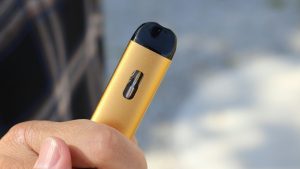The nicotine concentration in vape pods spans a broad spectrum from 0mg to 50mg/ml. This article analyzes concentration differences across devices, scientifically converts cigarette equivalents, and guides precise matching strategies—whether transitioning from cigarettes, controlling intake, or exploring flavor-only experiences, all backed by data-driven decision-making.
Decoding Three Pod Systems: Full Analysis of Nicotine Concentrations
1. Disposable Vape Pods
Nicotine content: 20-50mg/ml
Features: All-in-one design, ready-to-use
Target users: Heavy smokers needing instant satisfaction
2. Closed Pod System
Nicotine content: 3-50mg/ml (pre-filled)
Features: Replaceable cartridges, single pod ≈ one cigarette pack intake
Advantage: Balances convenience and moderate customization
3. Refillable Pod System
Nicotine content: 0-50mg/ml (self-filled)
Features: Compatible with freebase/salt nicotine oils
Core value: Long-term economy and full c
ustomization
Scientific Nicotine Intake Conversion: Cigarette Equivalent Guide
A traditional cigarette delivers 0.5-2.4mg nicotine through ~10 puffs (0.05-0.24mg per puff). Nicotine pods intake can be assessed via device parameters:
50mg/ml disposable pod: ~0.1mg/puff (equivalent to one cigarette)
20mg/ml closed pod system: ~0.07mg/puff (equivalent to half a cigarette)
Precision Matching Strategy: Concentration Tactics from Quitting to Pure Flavor
1. Cigarette Transition Phase
Use 40-50mg/ml nicotine salt pods. Their 5-minute blood peak time mirrors cigarettes’ metabolic curve, significantly easing withdrawal symptoms.
2. Nicotine Reduction Stage
Choose 3-12mg/ml freebase nicotine oils in refillable pod vape systems. Achieves gradual reduction with 60%+ less throat irritation.
3. Pure Flavor Experience
Directly select 0mg oils to eliminate nicotine dependency risks.
Health Safety Essence: Authoritative Data on Combustion vs. Vaporization
Traditional cigarettes release tar, carbon monoxide, and 69 IARC-classified carcinogens via ultra-high-temperature combustion (>800°C), producing 4,000+ byproducts per cigarette. Vape pods utilize precision temperature-controlled vaporization (200-350°C), avoiding pyrolysis. Their aerosol core components include:
99.5% pure nicotine
USP-certified pharmaceutical-grade propylene glycol
Food-grade vegetable glycerin
EU FEMA GRAS-certified flavor
s
Clinical studies confirm 89% nicotine delivery efficiency vs. cigarettes, with no detected benzopyrene (Journal of Nicotine and Tobacco Research, 2024).
Practical Operation Guide: Device · Concentration · Storage Technical Standards
1. Device Selection Matches Technical Parameters
Disposable vape pods typically hold ≥14ml liquid. Using industry formula “e-liquid ml × 250 puffs/ml” ensures 7,000-puff endurance. Closed systems prefer 1.8-2.0ml cartridges for daily use. Refillable pod systems should use 0.6-1.2Ω coils—lower resistance boosts efficiency but increases e-liquid consumption by 10-15%.
2. Concentration Calibration Follows Pharmacokinetics
≥20 cigarettes/day smokers: 40-50mg/ml nicotine salt.
<10 cigarettes/day: 20mg/ml balanced solution.
Zero-nicotine users: 0mg oils.
3. Storage & Maintenance Protocols
Store pods at 10-25°C with <60% humidity. Nicotine decomposes above 290°C, while >80% humidity accelerates oxidation. Use OLED-equipped devices to monitor e-liquid levels and prevent dry-burn aldehydes.
Controlling concentration means controlling choice
Nicotine management in vape pods has never been just a numbers game. From analyzing device characteristics to matching pharmacokinetics, from environmental control t
o personalized solution design—the essence lies in reconstructing the consumption decision chain through technical understanding. When you fully grasp the transmission pat
h and impact of each milligram of nicotine, you gain true freedom of choice.
EZEA will continue to provide you with technical verification support:
Device performance validation (e.g., vaporization efficiency and endurance calibration)
Concentration step optimization (reduction design based on metabolic curves)
Usage environment adaptation (solutions for special temperature and humidity conditions)
Our professional consultation channel is always open to you!
Post time: 08-20-25

